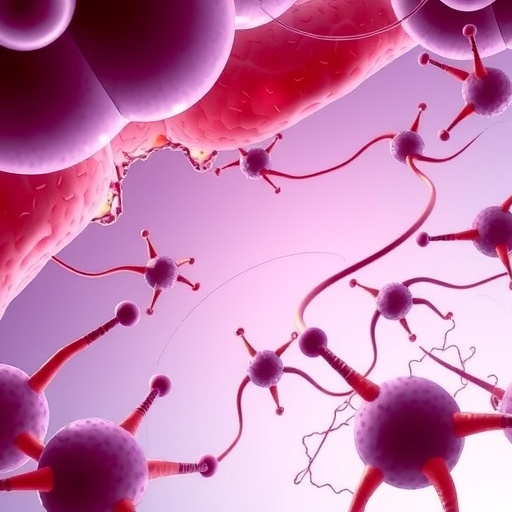In recent years, the intricate relationship between tumor biology and immune response has garnered significant attention, especially in the realm of metastatic cancers where treatment outcomes remain unpredictable. A groundbreaking study published in Nature Communications by Kamatani et al. uncovers a pivotal factor influencing the efficacy of immunotherapy in metastatic urothelial carcinoma: clonal diversity within tumor cells. This comprehensive investigation sheds light on how genetically diverse tumor cell populations sculpt the tumor microenvironment (TME), ultimately dictating divergent immunotherapy responses. The implications of such findings could revolutionize patient stratification and therapeutic approaches in urothelial carcinoma and potentially other malignancies.
Metastatic urothelial carcinoma represents a formidable clinical challenge due to its aggressive nature and limited treatment arsenal. Immunotherapy, particularly immune checkpoint inhibitors targeting PD-1/PD-L1 pathways, has emerged as a beacon of hope, yet clinical responses remain heterogeneous. Kamatani and colleagues hypothesized that beyond mere presence of immune cells or checkpoint expression, the intrinsic clonal architecture within tumors might play a crucial role in modulating the immune landscape. By delving into the genomic and immunological intricacies of tumor biopsies, their study paints a detailed picture of this dynamic interplay.
Central to tumor progression is the genetic heterogeneity exhibited by malignant cells. This heterogeneity manifests as distinct clones harboring unique mutational signatures, copy number alterations, and gene expression profiles. Kamatani’s team utilized high-depth whole-exome sequencing and transcriptomic analysis to dissect the clonal composition of metastatic urothelial tumors. Their analyses revealed that tumors with pronounced clonal diversity harbored distinct immune microenvironments compared to those dominated by a single or fewer clones, underscoring the complexity introduced by clonal evolution.
Intriguingly, tumors characterized by high clonal diversity exhibited a microenvironment enriched for immunosuppressive features. For instance, these tumors showed elevated levels of regulatory T cells and myeloid-derived suppressor cells, both instrumental in dampening anti-tumor immunity. Moreover, gene expression profiles from these tumors reflected upregulation of pathways involved in immune evasion, such as TGF-beta signaling, which is notorious for fostering an immunologically “cold” TME. This milieu hinders effective cytotoxic T cell infiltration and activity, posing a significant barrier to immunotherapy efficacy.
Conversely, metastatic tumors with low clonal diversity tended to foster an inflammatory microenvironment more conducive to immune-mediated tumor eradication. These tumors displayed increased infiltration of activated CD8+ T cells and higher expression of interferon-gamma-responsive genes, a hallmark of an immunologically “hot” tumor microenvironment. Such patients demonstrated markedly superior responses to immune checkpoint blockade, highlighting clonal diversity as a predictive biomarker for treatment success.
The functional consequences of clonal diversity extend beyond mere immune infiltration patterns. Kamatani et al. probed the spatial distribution of clones within tumor tissues using multiplexed immunohistochemistry and spatial transcriptomics. Their findings illustrated heterogeneous localization of genetically distinct clones correlating with discrete immune niches. Some clones resided within regions enriched with suppressive macrophages and exhausted T cells, while others occupied areas of heightened immune activation. This spatial heterogeneity underscores the adaptive tactics tumors employ to evade immune surveillance in a clonal-specific manner.
Expanding on mechanistic insights, the team investigated the mutational burden and neoantigen landscapes across clones. High clonal diversity tumors paradoxically demonstrated a broad spectrum of neoantigens; however, immune editing appeared more pronounced in these tumors, resulting in selective loss of highly immunogenic clones. This phenomenon suggests a Darwinian selection within the tumor ecosystem where immune pressure sculpts clonal composition, further complicating therapeutic interventions.
From a translational perspective, these findings challenge the current paradigms in patient stratification for immunotherapy. Traditional biomarkers such as PD-L1 expression or tumor mutational burden alone may be insufficient to capture the nuanced immune-tumor dynamics governed by clonal diversity. Integrating clonal composition analysis into clinical workflows could refine prognostication and inform rational combination therapies tailored to overcome specific immunosuppressive mechanisms inherent to clonal heterogeneity.
Moreover, the study’s revelations prompt reconsideration of therapeutic timing and modality. For instance, tumors with high clonal diversity might benefit from initial strategies that remodel the tumor microenvironment—perhaps using TGF-beta inhibitors or macrophage-targeting agents—preceding or concurrent with checkpoint blockade. Alternatively, multi-targeted immunotherapies designed to address distinct clones simultaneously could preempt immune escape phenomena.
The technological advancements employed in this research are as transformative as the biological insights. The application of spatial transcriptomics provided unprecedented resolution into tumor-immune interactions within the three-dimensional tumor architecture, enabling a more holistic understanding of clonal impacts on microenvironmental niches. These methodologies set a new standard for future oncological investigations, facilitating granular dissection of tumor heterogeneity and immune modulation.
Kamatani and colleagues also underscore the importance of integrating longitudinal sampling in future studies. Tumor clonal landscapes evolve dynamically, especially under therapeutic pressure. Tracking these changes over time would elucidate the mechanisms underpinning acquired resistance to immunotherapy and identify windows of vulnerability exploitable by novel interventions.
This pioneering work opens avenues for biomarker development that incorporates not only genetic and immunological parameters but also their spatial and temporal dimensions. By encapsulating the multi-layered complexity of tumor ecosystems, such biomarkers promise to elevate precision oncology to new heights, delivering personalized therapies matched to the unique clonal and immune topography of each patient’s cancer.
Furthermore, the implications of clonal diversity extend beyond urothelial carcinoma, possibly informing treatment strategies across a spectrum of solid tumors. As comprehensive genomic profiling becomes more accessible, the principles delineated here are poised to have broad clinical impact, ushering in an era where clonal architecture guides therapeutic design and monitoring.
In conclusion, the study by Kamatani et al. represents a milestone in cancer biology, emphasizing the indispensable role of clonal diversity in shaping tumor-immune dialogues. Their integrative approach, blending genomics, spatial biology, and immunology, charts a promising pathway towards overcoming the challenges of metastatic urothelial carcinoma. As the oncology community embraces these insights, the dream of durable, effective immunotherapies for hard-to-treat cancers inches closer to reality.
Subject of Research: Clonal diversity in metastatic urothelial carcinoma and its impact on tumor microenvironment and immunotherapy response
Article Title: Clonal diversity shapes the tumour microenvironment leading to distinct immunotherapy responses in metastatic urothelial carcinoma
Article References:
Kamatani, T., Umeda, K., Iwasawa, T. et al. Clonal diversity shapes the tumour microenvironment leading to distinct immunotherapy responses in metastatic urothelial carcinoma. Nat Commun 16, 7995 (2025). https://doi.org/10.1038/s41467-025-63309-1
Image Credits: AI Generated
Tags: clonal architecture and therapeutic outcomesclonal diversity in tumorsgenetic heterogeneity in cancer cellsgenomic analysis of urothelial carcinomaImmune checkpoint inhibitors in cancer therapyimmunotherapy efficacy and clonal diversityimmunotherapy response in urothelial cancermetastatic urothelial carcinoma treatment challengesNature Communications study on cancerpatient stratification in immunotherapytumor biology and immune interactiontumor microenvironment and immune response





